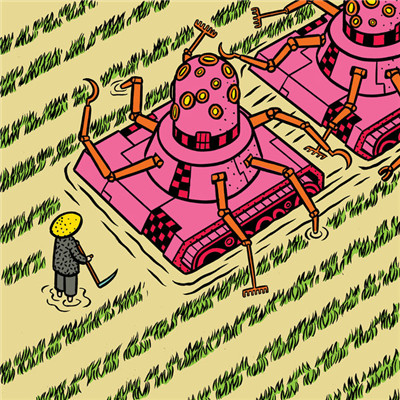(单词翻译:单击)
OVER the last decade, China has become, in the eyes of much of the world, a job-eating monster, consuming entire industries with its seemingly limitless supply of low-wage workers. But the reality is that China is now shifting its appetite to robots, a transition that will have significant consequences for China’s economy — and the world’s.
在全球很多地方看来,过去十年中国已经成了一个侵蚀工作机会的恶魔,向各行各业输送着仿佛无穷无尽的廉价工人。但现实是,中国目前正在将自己的用工需求转向机器人。这一转变将对中国以及全球的经济产生重大影响。
In 2014, Chinese factories accounted for about a quarter of the global ranks of industrial robots — a 54 percent increase over 2013. According to the International Federation of Robotics, it will have more installed manufacturing robots than any other country by 2017.
2014年,在全球工业机器人大军中,中国工厂里的机器人占了大约四分之一,同比增加54%。据国际机器人联合会(International Federation of Robotics)称,到2017年,中国安装的工业机器人数量将居全球之首。

Midea, a leading manufacturer of home appliances in the heavily industrialized province of Guangdong, plans to replace 6,000 workers in its residential air-conditioning division, about a fifth of the work force, with automation by the end of the year. Foxconn, which makes consumer electronics for Apple and other companies, plans to automate about 70 percent of factory work within three years, and already has a fully robotic factory in Chengdu.
在高度工业化的广东,知名家电制造商美的计划在今年年底之前,用自动化取代其家用空调部门的6000名员工,这大约是其员工总数的五分之一。为苹果(Apple)和其他公司生产消费电子产品的富士康(Foxconn)计划在三年内让工厂里大约70%的工作实现自动化。此外,该公司位于成都的一家工厂已经实现了全部由机器人操作。
Chinese factory jobs may thus be poised to evaporate at an even faster pace than has been the case in the United States and other developed countries. That may make it significantly more difficult for China to address one of its paramount economic challenges: the need to rebalance its economy so that domestic consumption plays a far more significant role than is currently the case.
因此,中国工厂里的工作岗位消失的速度,可能将比在美国和其他发达国家还要快。这可能会大大增加中国应对其首要经济挑战之一的难度。这个挑战就是,中国需要实现经济的再平衡,这样国内消费才能发挥出远比当前更大的作用。
China’s economic growth has been driven not just by manufacturing exports, but also by fixed investment in things like housing, factories and infrastructure — in fact, in recent years investment has made up nearly half of its gross domestic product. Meanwhile, domestic consumer spending represents only about a third of the economic pie, or roughly half the level in the United States.
中国经济增长的动力不仅是制造业出口,还有房地产、工厂和基础设施领域的固定投资。事实上,近年来投资在其国内生产总值中所占的比例已接近一半。与此同时,国内消费支出仅占中国经济这个蛋糕的约三分之一,大致相当于美国的一半。
This is clearly unsustainable. After all, there eventually has to be a return on all those investments. Factories have to produce goods that are profitably sold. Homes have to be occupied, and rent has to be paid. Generating those returns will require Chinese households to step up and play a larger role: They will have to spend far more, not just on the goods produced in China’s factories, but increasingly in the service sector.
这显然是不可持续的。毕竟,所有这些投资最后都得有回报。工厂得生产出能卖出去并且能获利的商品。房子得有人住,房租得有人付。实现这些回报要求中国家庭出来发挥更大的作用:他们得大大增加支出,不仅是购买中国工厂生产的商品,而且要越来越多地在服务业消费。
Making that happen will be an extraordinary challenge. Indeed, the Chinese leadership has been talking about it for years, but virtually no progress has been made. One problem is that even in the wake of recent wage increases, average Chinese households simply have too little income relative to the size of the economy.
实现这一点将是一项艰巨的挑战。事实上中国领导层已经讨论了多年,但几乎未取得任何进展。其中一个问题是,即便经历了最近的涨薪,相对于中国的经济规模,普通中国家庭的收入也还是太少。
Another problem is that the Chinese public has an extraordinary propensity to save. By some estimates, the average household socks away as much as 40 percent of its income. That may be partly driven by the need to provide for retirement and self-insure against risks like unemployment and illness, as China’s newly capitalistic economy has largely decimated the social safety net.
另一个问题是,中国民众有着非比寻常的储蓄倾向。据一些人估计,普通家庭存款占其收入的比例高达40%。这可能部分是因为他们需要为退休,以及抵抗失业和疾病等危险的自保考虑,因为中国新形成的资本主义经济大大削弱了社会保障体系。
The bottom line is that any policy designed to rebalance economic growth will have to raise household incomes while dampening down the saving rate. That would be a daunting challenge under any circumstances, but accelerating technology is virtually certain to make it far more difficult.
关键是,任何旨在再平衡经济增长的政策,都得在增加家庭收入的同时降低储蓄率。这在任何情况下都是一项艰巨的挑战,但技术的进步几乎必然会让其难度大大增加。
The traditional path followed by developed countries has been to first raise incomes and build a solid middle class on the basis of manufacturing, and then later to make the transition to a service economy. The United States, and later, countries like Japan and South Korea, had the luxury of undertaking that journey at a time when technology was far less advanced. China is faced with making a similar transition in the robotic age.
发达国家采取的传统途径是,先增加收入,并以制造业为基础构建稳定的中产阶级,然后再向服务型经济过渡。美国,以及后来的日本和韩国等国,都有幸在科技远没现在这么发达时完成了这个过程。中国则正面临着在机器人时代进行类似的过渡。
Automation has already had a substantial impact on Chinese factory employment: Between 1995 and 2002 about 16 million factory jobs disappeared, roughly 15 percent of total Chinese manufacturing employment. This trend is poised to accelerate.
自动化已经对中国工厂里的就业岗位产生了巨大的影响:从1995年到2002年,约有1600万工厂工作岗位消失,大约占中国制造业岗位总数的15%。这一趋势还将加速。
That might not be a problem if the Chinese economy were generating plenty of higher-skill jobs for more educated workers. The solution, then, would simply be to offer more training and education to displaced blue-collar workers.
如果中国经济能为受教育更多的人创造大量技能要求更高的岗位,这或许就不是问题了。那么解决办法不过是向被取代了的蓝领工人提供更多培训和教育。
The reality, however, is that China has struggled to create enough white-collar jobs for its soaring population of college graduates. In mid-2013, the Chinese government revealed that only about half of the country’s current crop of college graduates had been able to find jobs, while more than 20 percent of the previous year’s graduates remained unemployed.
但现实是,中国已无力为人数飙升的高校毕业生创造足够的白领岗位。2013年中期,中国政府透露,只有大约一半应届高校毕业生能找到工作,而上一年的毕业生中超过20%的人依然处于待业状态。
According to one analysis, fully 43 percent of Chinese workers already consider themselves to be overeducated for their current positions. As software automation and artificial intelligence increasingly affect knowledge-based occupations, especially at the entry level, it may well become even more difficult for the Chinese economy to absorb workers who seek to climb the skills ladder.
一项分析显示,已有足足43%的中国员工认为,自己的教育程度高于当前职位所需。随着软件自动化和人工智能对于以知识为基础的岗位,特别是入门岗位产生越来越大的影响,中国经济会更难吸纳那些希望提升技能的员工。
What policies might help China succeed in making the transition to a consumer economy even as the robotic revolution unfolds? Strengthening the health care, retirement and unemployment insurance systems, so that workers feel more secure, might help lower the savings rate somewhat.
什么政策可以帮助中国成功地实现向消费型经济的转型,即便此时机器人革命正在上演?加强医疗卫生、退休和失业保险制度,从而提升员工的安全感,这可能在一定程度上有助于降低储蓄率。
However, it seems likely that the Chinese government will ultimately need to resort to direct income supplementation in some form — perhaps through a program similar to the earned-income tax credit in the United States. Even that may prove ineffective in the long run as rapidly advancing technology leaves more and more workers behind.
不过,中国政府最终可能需要借助于某种形式的直接收入补充,或许是通过某种与美国的“劳动所得税抵免”(earned-income tax credit)类似的计划来实现。即便如此,长期来看可能也没有效果,因为科技的迅速发展,将越来越多的员工抛在了身后。
China could well turn out to be ground zero for the economic and social disruption brought on by the rise of the robots. The country’s relatively brittle authoritarian political system, together with its dependence on a sustained level of economic growth that would be considered extraordinary in any developed nation, suggest that China may face a staggering challenge as it attempts to adapt to the realities of a new age.
在机器人的崛起所带来的经济和社会破坏当中,中国很可能会是一个中心。中国的威权主义政治制度相对脆弱,而且依赖于持续的经济增长,其经济增长水平在任何一个发达国家看来都是超乎寻常的。这两点表明,在试图适应新时代的现实时,中国可能面临着巨大的挑战。


